Nursing Plan of Care for Schizoaffective Disorder: A Case Study
VerifiedAdded on 2023/01/23
|11
|2995
|42
AI Summary
This article discusses the nursing plan of care for a case study on a patient with schizoaffective disorder, including priorities of care, psychosocial aspects, specific nursing interventions, and biological treatments.
Contribute Materials
Your contribution can guide someone’s learning journey. Share your
documents today.
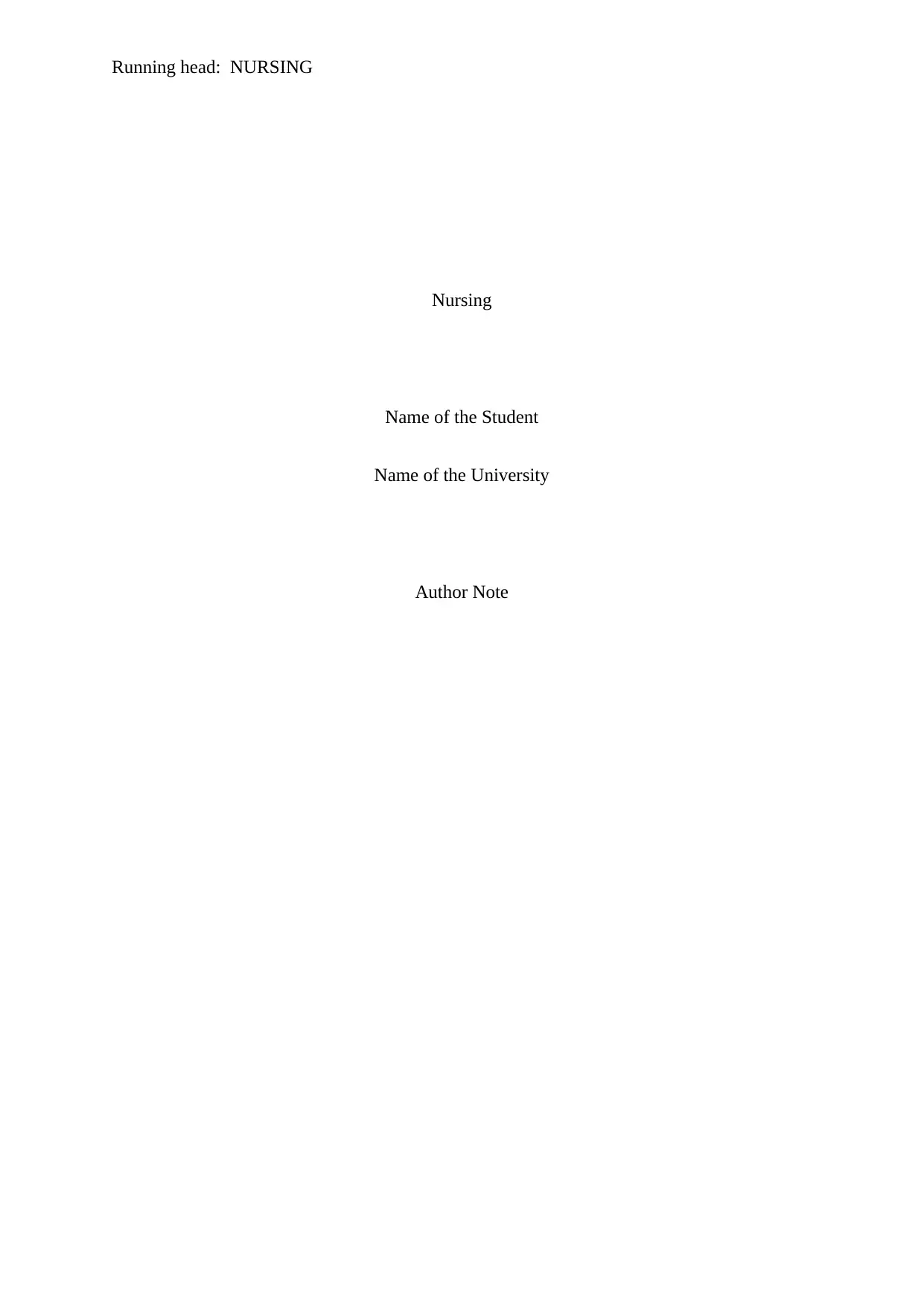
Running head: NURSING
Nursing
Name of the Student
Name of the University
Author Note
Nursing
Name of the Student
Name of the University
Author Note
Secure Best Marks with AI Grader
Need help grading? Try our AI Grader for instant feedback on your assignments.
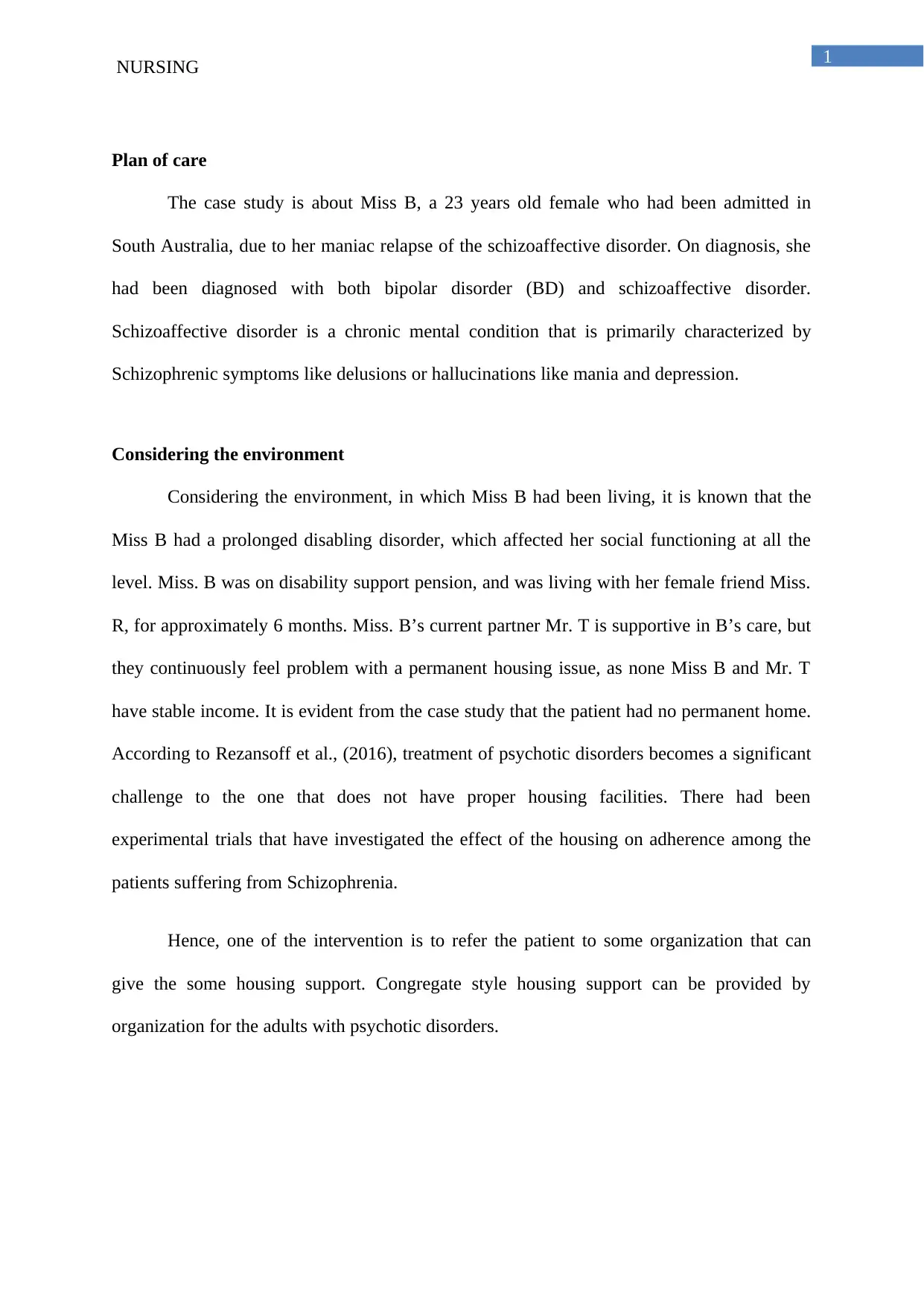
1
NURSING
Plan of care
The case study is about Miss B, a 23 years old female who had been admitted in
South Australia, due to her maniac relapse of the schizoaffective disorder. On diagnosis, she
had been diagnosed with both bipolar disorder (BD) and schizoaffective disorder.
Schizoaffective disorder is a chronic mental condition that is primarily characterized by
Schizophrenic symptoms like delusions or hallucinations like mania and depression.
Considering the environment
Considering the environment, in which Miss B had been living, it is known that the
Miss B had a prolonged disabling disorder, which affected her social functioning at all the
level. Miss. B was on disability support pension, and was living with her female friend Miss.
R, for approximately 6 months. Miss. B’s current partner Mr. T is supportive in B’s care, but
they continuously feel problem with a permanent housing issue, as none Miss B and Mr. T
have stable income. It is evident from the case study that the patient had no permanent home.
According to Rezansoff et al., (2016), treatment of psychotic disorders becomes a significant
challenge to the one that does not have proper housing facilities. There had been
experimental trials that have investigated the effect of the housing on adherence among the
patients suffering from Schizophrenia.
Hence, one of the intervention is to refer the patient to some organization that can
give the some housing support. Congregate style housing support can be provided by
organization for the adults with psychotic disorders.
NURSING
Plan of care
The case study is about Miss B, a 23 years old female who had been admitted in
South Australia, due to her maniac relapse of the schizoaffective disorder. On diagnosis, she
had been diagnosed with both bipolar disorder (BD) and schizoaffective disorder.
Schizoaffective disorder is a chronic mental condition that is primarily characterized by
Schizophrenic symptoms like delusions or hallucinations like mania and depression.
Considering the environment
Considering the environment, in which Miss B had been living, it is known that the
Miss B had a prolonged disabling disorder, which affected her social functioning at all the
level. Miss. B was on disability support pension, and was living with her female friend Miss.
R, for approximately 6 months. Miss. B’s current partner Mr. T is supportive in B’s care, but
they continuously feel problem with a permanent housing issue, as none Miss B and Mr. T
have stable income. It is evident from the case study that the patient had no permanent home.
According to Rezansoff et al., (2016), treatment of psychotic disorders becomes a significant
challenge to the one that does not have proper housing facilities. There had been
experimental trials that have investigated the effect of the housing on adherence among the
patients suffering from Schizophrenia.
Hence, one of the intervention is to refer the patient to some organization that can
give the some housing support. Congregate style housing support can be provided by
organization for the adults with psychotic disorders.
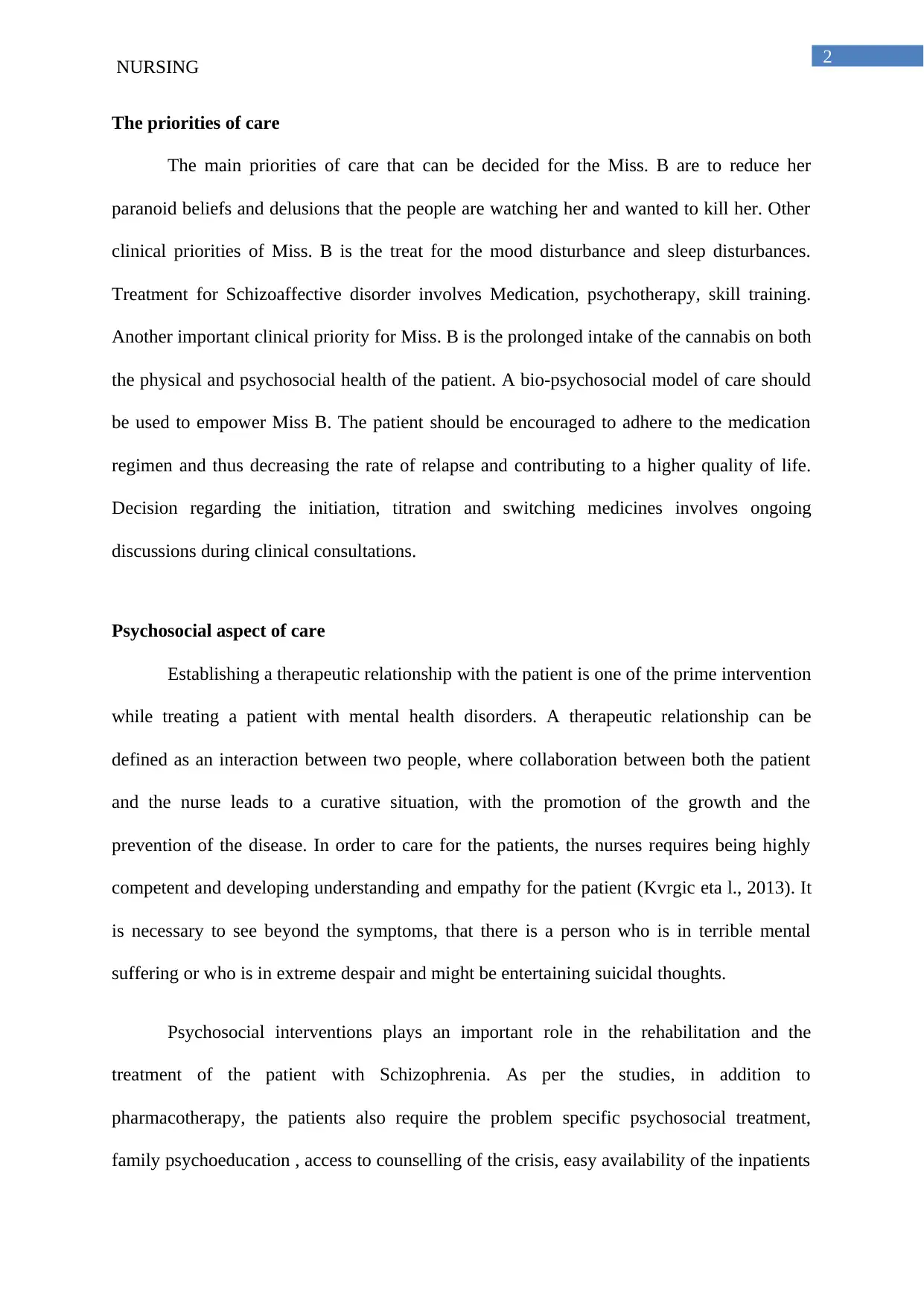
2
NURSING
The priorities of care
The main priorities of care that can be decided for the Miss. B are to reduce her
paranoid beliefs and delusions that the people are watching her and wanted to kill her. Other
clinical priorities of Miss. B is the treat for the mood disturbance and sleep disturbances.
Treatment for Schizoaffective disorder involves Medication, psychotherapy, skill training.
Another important clinical priority for Miss. B is the prolonged intake of the cannabis on both
the physical and psychosocial health of the patient. A bio-psychosocial model of care should
be used to empower Miss B. The patient should be encouraged to adhere to the medication
regimen and thus decreasing the rate of relapse and contributing to a higher quality of life.
Decision regarding the initiation, titration and switching medicines involves ongoing
discussions during clinical consultations.
Psychosocial aspect of care
Establishing a therapeutic relationship with the patient is one of the prime intervention
while treating a patient with mental health disorders. A therapeutic relationship can be
defined as an interaction between two people, where collaboration between both the patient
and the nurse leads to a curative situation, with the promotion of the growth and the
prevention of the disease. In order to care for the patients, the nurses requires being highly
competent and developing understanding and empathy for the patient (Kvrgic eta l., 2013). It
is necessary to see beyond the symptoms, that there is a person who is in terrible mental
suffering or who is in extreme despair and might be entertaining suicidal thoughts.
Psychosocial interventions plays an important role in the rehabilitation and the
treatment of the patient with Schizophrenia. As per the studies, in addition to
pharmacotherapy, the patients also require the problem specific psychosocial treatment,
family psychoeducation , access to counselling of the crisis, easy availability of the inpatients
NURSING
The priorities of care
The main priorities of care that can be decided for the Miss. B are to reduce her
paranoid beliefs and delusions that the people are watching her and wanted to kill her. Other
clinical priorities of Miss. B is the treat for the mood disturbance and sleep disturbances.
Treatment for Schizoaffective disorder involves Medication, psychotherapy, skill training.
Another important clinical priority for Miss. B is the prolonged intake of the cannabis on both
the physical and psychosocial health of the patient. A bio-psychosocial model of care should
be used to empower Miss B. The patient should be encouraged to adhere to the medication
regimen and thus decreasing the rate of relapse and contributing to a higher quality of life.
Decision regarding the initiation, titration and switching medicines involves ongoing
discussions during clinical consultations.
Psychosocial aspect of care
Establishing a therapeutic relationship with the patient is one of the prime intervention
while treating a patient with mental health disorders. A therapeutic relationship can be
defined as an interaction between two people, where collaboration between both the patient
and the nurse leads to a curative situation, with the promotion of the growth and the
prevention of the disease. In order to care for the patients, the nurses requires being highly
competent and developing understanding and empathy for the patient (Kvrgic eta l., 2013). It
is necessary to see beyond the symptoms, that there is a person who is in terrible mental
suffering or who is in extreme despair and might be entertaining suicidal thoughts.
Psychosocial interventions plays an important role in the rehabilitation and the
treatment of the patient with Schizophrenia. As per the studies, in addition to
pharmacotherapy, the patients also require the problem specific psychosocial treatment,
family psychoeducation , access to counselling of the crisis, easy availability of the inpatients
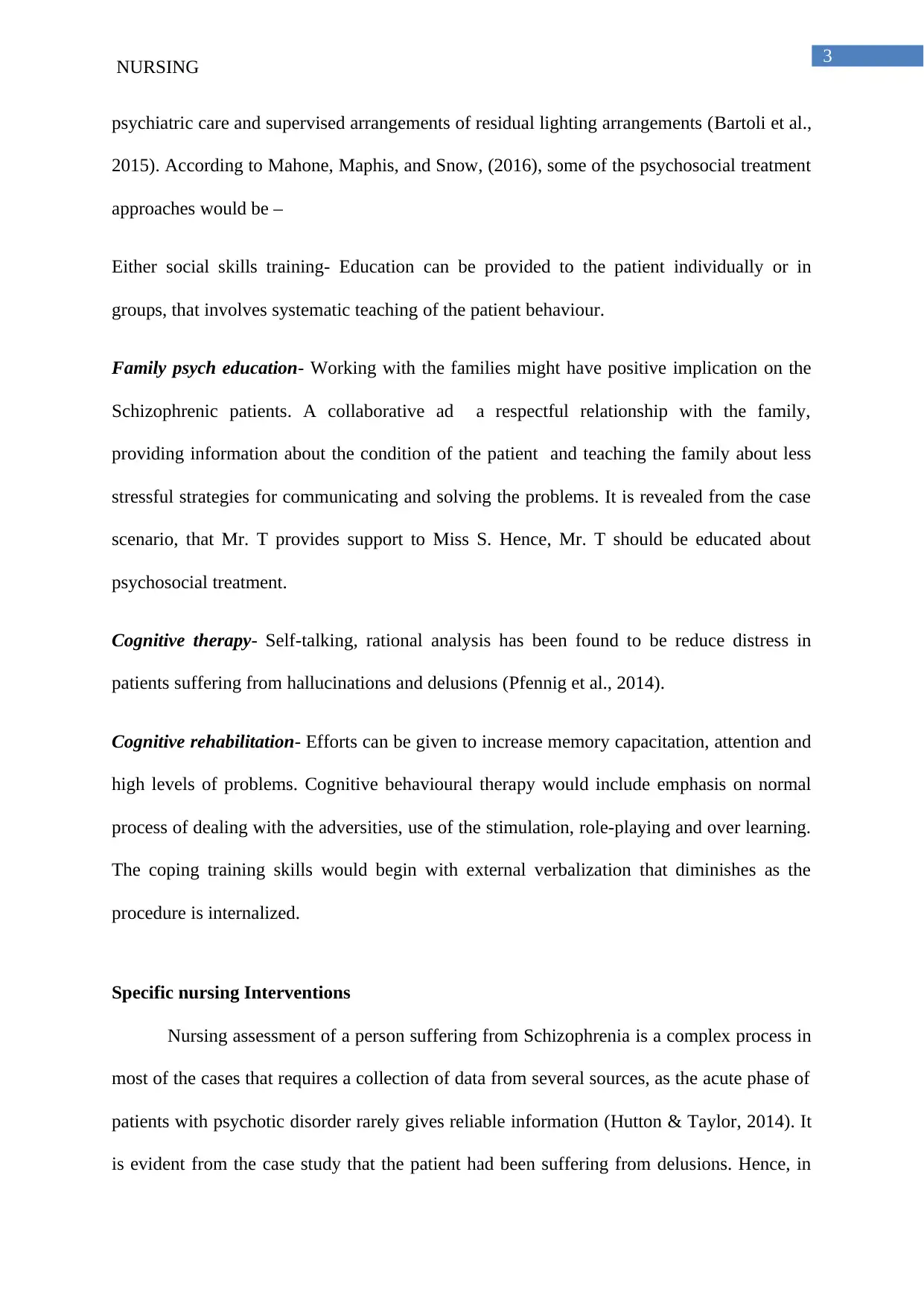
3
NURSING
psychiatric care and supervised arrangements of residual lighting arrangements (Bartoli et al.,
2015). According to Mahone, Maphis, and Snow, (2016), some of the psychosocial treatment
approaches would be –
Either social skills training- Education can be provided to the patient individually or in
groups, that involves systematic teaching of the patient behaviour.
Family psych education- Working with the families might have positive implication on the
Schizophrenic patients. A collaborative ad a respectful relationship with the family,
providing information about the condition of the patient and teaching the family about less
stressful strategies for communicating and solving the problems. It is revealed from the case
scenario, that Mr. T provides support to Miss S. Hence, Mr. T should be educated about
psychosocial treatment.
Cognitive therapy- Self-talking, rational analysis has been found to be reduce distress in
patients suffering from hallucinations and delusions (Pfennig et al., 2014).
Cognitive rehabilitation- Efforts can be given to increase memory capacitation, attention and
high levels of problems. Cognitive behavioural therapy would include emphasis on normal
process of dealing with the adversities, use of the stimulation, role-playing and over learning.
The coping training skills would begin with external verbalization that diminishes as the
procedure is internalized.
Specific nursing Interventions
Nursing assessment of a person suffering from Schizophrenia is a complex process in
most of the cases that requires a collection of data from several sources, as the acute phase of
patients with psychotic disorder rarely gives reliable information (Hutton & Taylor, 2014). It
is evident from the case study that the patient had been suffering from delusions. Hence, in
NURSING
psychiatric care and supervised arrangements of residual lighting arrangements (Bartoli et al.,
2015). According to Mahone, Maphis, and Snow, (2016), some of the psychosocial treatment
approaches would be –
Either social skills training- Education can be provided to the patient individually or in
groups, that involves systematic teaching of the patient behaviour.
Family psych education- Working with the families might have positive implication on the
Schizophrenic patients. A collaborative ad a respectful relationship with the family,
providing information about the condition of the patient and teaching the family about less
stressful strategies for communicating and solving the problems. It is revealed from the case
scenario, that Mr. T provides support to Miss S. Hence, Mr. T should be educated about
psychosocial treatment.
Cognitive therapy- Self-talking, rational analysis has been found to be reduce distress in
patients suffering from hallucinations and delusions (Pfennig et al., 2014).
Cognitive rehabilitation- Efforts can be given to increase memory capacitation, attention and
high levels of problems. Cognitive behavioural therapy would include emphasis on normal
process of dealing with the adversities, use of the stimulation, role-playing and over learning.
The coping training skills would begin with external verbalization that diminishes as the
procedure is internalized.
Specific nursing Interventions
Nursing assessment of a person suffering from Schizophrenia is a complex process in
most of the cases that requires a collection of data from several sources, as the acute phase of
patients with psychotic disorder rarely gives reliable information (Hutton & Taylor, 2014). It
is evident from the case study that the patient had been suffering from delusions. Hence, in
Secure Best Marks with AI Grader
Need help grading? Try our AI Grader for instant feedback on your assignments.

4
NURSING
presence of delusions, nurses should demonstrate to patients that they accept that the patients
has this belief, although they do not share the same belief. It is important no viewpoint has to
be denied. Nurse should reinforce reality and should talk about people that are in real
avoiding ruminant thinking in false patients.
In order to control hallucinations, nurses should promote safety, and the orientation of
the patient towards reality. It is necessary for the nurse to observe certain signs like the
talking and the listening posture of the patient (Amann et al., 2017). It is revealed from the
initial mental health examination, that she made a fixed look on the wall and had no
orientation to time, place and person. Nurses should be able display attitude of acceptance to
assist the patient share the content of delusional thoughts. Listening to music or watching
television can be used as good distract ion techniques (Kvrgic eta l., 2013).
The case study revealed that Miss,. B had been suffering from sleep disorder. As
reported in the study by Kaskie, Graziano and Ferrarelli, (2017), a vast number of
Schizophrenic patients report sleep disturbances, that tend to precede illness onset and can
predict the severe exacerbation of the psychotic symptoms. Non-pharmacological
interventions for sleep disturbances would include, cognitive behavioral therapy, which has
been shown to be effective against patients with insomnia and Schizophrenia..
The main nursing interventions for patients suffering from mood disorders included
assessing the level of suicide precautions necessary, encourage the client to talk about
emotions and feelings, engage the patients in activities that does not require competition or
concentration (Tondo & Baldessarini, 2016). Miss. B should be taught about the techniques
that replace the negative images with the positive images.
NURSING
presence of delusions, nurses should demonstrate to patients that they accept that the patients
has this belief, although they do not share the same belief. It is important no viewpoint has to
be denied. Nurse should reinforce reality and should talk about people that are in real
avoiding ruminant thinking in false patients.
In order to control hallucinations, nurses should promote safety, and the orientation of
the patient towards reality. It is necessary for the nurse to observe certain signs like the
talking and the listening posture of the patient (Amann et al., 2017). It is revealed from the
initial mental health examination, that she made a fixed look on the wall and had no
orientation to time, place and person. Nurses should be able display attitude of acceptance to
assist the patient share the content of delusional thoughts. Listening to music or watching
television can be used as good distract ion techniques (Kvrgic eta l., 2013).
The case study revealed that Miss,. B had been suffering from sleep disorder. As
reported in the study by Kaskie, Graziano and Ferrarelli, (2017), a vast number of
Schizophrenic patients report sleep disturbances, that tend to precede illness onset and can
predict the severe exacerbation of the psychotic symptoms. Non-pharmacological
interventions for sleep disturbances would include, cognitive behavioral therapy, which has
been shown to be effective against patients with insomnia and Schizophrenia..
The main nursing interventions for patients suffering from mood disorders included
assessing the level of suicide precautions necessary, encourage the client to talk about
emotions and feelings, engage the patients in activities that does not require competition or
concentration (Tondo & Baldessarini, 2016). Miss. B should be taught about the techniques
that replace the negative images with the positive images.
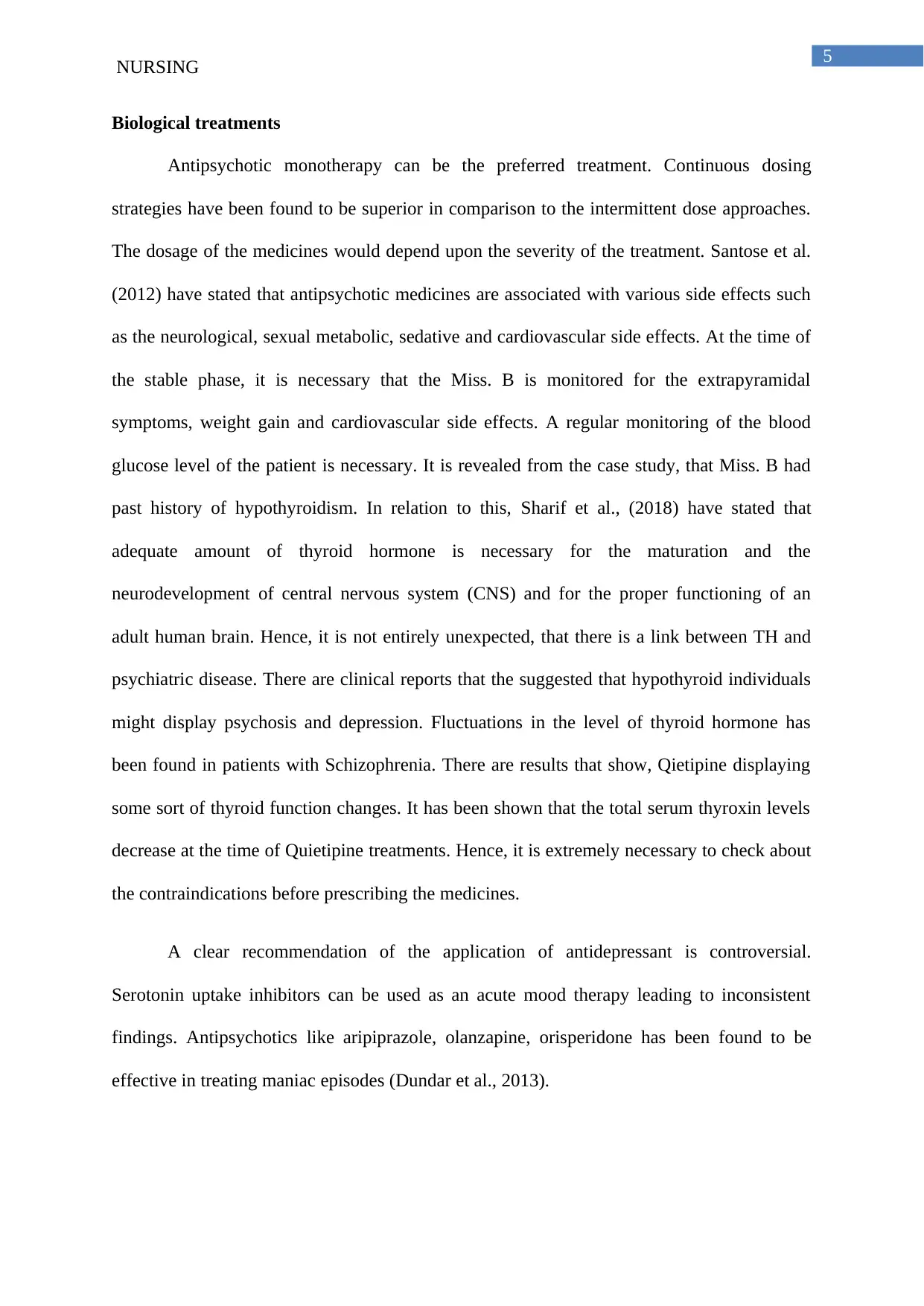
5
NURSING
Biological treatments
Antipsychotic monotherapy can be the preferred treatment. Continuous dosing
strategies have been found to be superior in comparison to the intermittent dose approaches.
The dosage of the medicines would depend upon the severity of the treatment. Santose et al.
(2012) have stated that antipsychotic medicines are associated with various side effects such
as the neurological, sexual metabolic, sedative and cardiovascular side effects. At the time of
the stable phase, it is necessary that the Miss. B is monitored for the extrapyramidal
symptoms, weight gain and cardiovascular side effects. A regular monitoring of the blood
glucose level of the patient is necessary. It is revealed from the case study, that Miss. B had
past history of hypothyroidism. In relation to this, Sharif et al., (2018) have stated that
adequate amount of thyroid hormone is necessary for the maturation and the
neurodevelopment of central nervous system (CNS) and for the proper functioning of an
adult human brain. Hence, it is not entirely unexpected, that there is a link between TH and
psychiatric disease. There are clinical reports that the suggested that hypothyroid individuals
might display psychosis and depression. Fluctuations in the level of thyroid hormone has
been found in patients with Schizophrenia. There are results that show, Qietipine displaying
some sort of thyroid function changes. It has been shown that the total serum thyroxin levels
decrease at the time of Quietipine treatments. Hence, it is extremely necessary to check about
the contraindications before prescribing the medicines.
A clear recommendation of the application of antidepressant is controversial.
Serotonin uptake inhibitors can be used as an acute mood therapy leading to inconsistent
findings. Antipsychotics like aripiprazole, olanzapine, orisperidone has been found to be
effective in treating maniac episodes (Dundar et al., 2013).
NURSING
Biological treatments
Antipsychotic monotherapy can be the preferred treatment. Continuous dosing
strategies have been found to be superior in comparison to the intermittent dose approaches.
The dosage of the medicines would depend upon the severity of the treatment. Santose et al.
(2012) have stated that antipsychotic medicines are associated with various side effects such
as the neurological, sexual metabolic, sedative and cardiovascular side effects. At the time of
the stable phase, it is necessary that the Miss. B is monitored for the extrapyramidal
symptoms, weight gain and cardiovascular side effects. A regular monitoring of the blood
glucose level of the patient is necessary. It is revealed from the case study, that Miss. B had
past history of hypothyroidism. In relation to this, Sharif et al., (2018) have stated that
adequate amount of thyroid hormone is necessary for the maturation and the
neurodevelopment of central nervous system (CNS) and for the proper functioning of an
adult human brain. Hence, it is not entirely unexpected, that there is a link between TH and
psychiatric disease. There are clinical reports that the suggested that hypothyroid individuals
might display psychosis and depression. Fluctuations in the level of thyroid hormone has
been found in patients with Schizophrenia. There are results that show, Qietipine displaying
some sort of thyroid function changes. It has been shown that the total serum thyroxin levels
decrease at the time of Quietipine treatments. Hence, it is extremely necessary to check about
the contraindications before prescribing the medicines.
A clear recommendation of the application of antidepressant is controversial.
Serotonin uptake inhibitors can be used as an acute mood therapy leading to inconsistent
findings. Antipsychotics like aripiprazole, olanzapine, orisperidone has been found to be
effective in treating maniac episodes (Dundar et al., 2013).
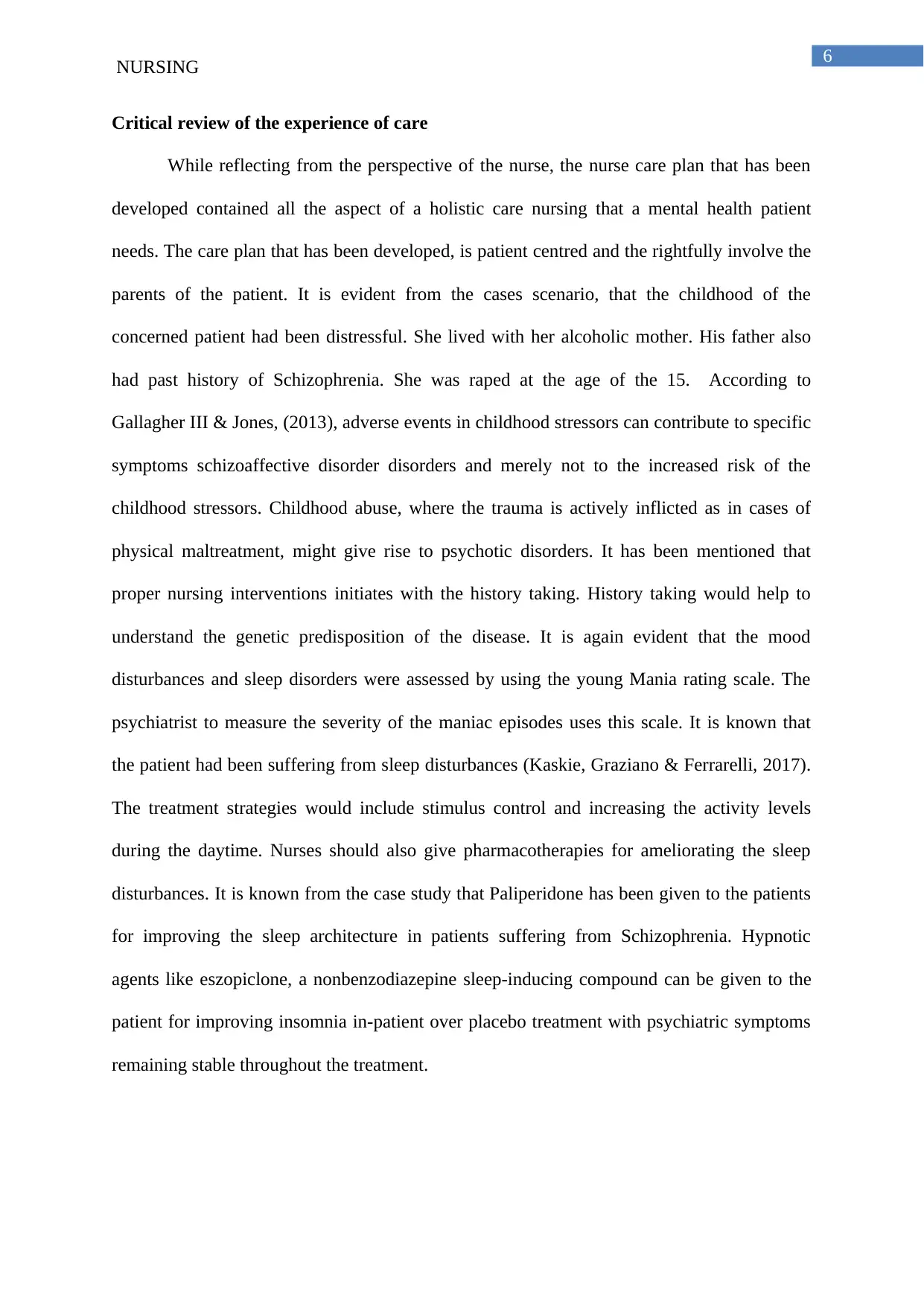
6
NURSING
Critical review of the experience of care
While reflecting from the perspective of the nurse, the nurse care plan that has been
developed contained all the aspect of a holistic care nursing that a mental health patient
needs. The care plan that has been developed, is patient centred and the rightfully involve the
parents of the patient. It is evident from the cases scenario, that the childhood of the
concerned patient had been distressful. She lived with her alcoholic mother. His father also
had past history of Schizophrenia. She was raped at the age of the 15. According to
Gallagher III & Jones, (2013), adverse events in childhood stressors can contribute to specific
symptoms schizoaffective disorder disorders and merely not to the increased risk of the
childhood stressors. Childhood abuse, where the trauma is actively inflicted as in cases of
physical maltreatment, might give rise to psychotic disorders. It has been mentioned that
proper nursing interventions initiates with the history taking. History taking would help to
understand the genetic predisposition of the disease. It is again evident that the mood
disturbances and sleep disorders were assessed by using the young Mania rating scale. The
psychiatrist to measure the severity of the maniac episodes uses this scale. It is known that
the patient had been suffering from sleep disturbances (Kaskie, Graziano & Ferrarelli, 2017).
The treatment strategies would include stimulus control and increasing the activity levels
during the daytime. Nurses should also give pharmacotherapies for ameliorating the sleep
disturbances. It is known from the case study that Paliperidone has been given to the patients
for improving the sleep architecture in patients suffering from Schizophrenia. Hypnotic
agents like eszopiclone, a nonbenzodiazepine sleep-inducing compound can be given to the
patient for improving insomnia in-patient over placebo treatment with psychiatric symptoms
remaining stable throughout the treatment.
NURSING
Critical review of the experience of care
While reflecting from the perspective of the nurse, the nurse care plan that has been
developed contained all the aspect of a holistic care nursing that a mental health patient
needs. The care plan that has been developed, is patient centred and the rightfully involve the
parents of the patient. It is evident from the cases scenario, that the childhood of the
concerned patient had been distressful. She lived with her alcoholic mother. His father also
had past history of Schizophrenia. She was raped at the age of the 15. According to
Gallagher III & Jones, (2013), adverse events in childhood stressors can contribute to specific
symptoms schizoaffective disorder disorders and merely not to the increased risk of the
childhood stressors. Childhood abuse, where the trauma is actively inflicted as in cases of
physical maltreatment, might give rise to psychotic disorders. It has been mentioned that
proper nursing interventions initiates with the history taking. History taking would help to
understand the genetic predisposition of the disease. It is again evident that the mood
disturbances and sleep disorders were assessed by using the young Mania rating scale. The
psychiatrist to measure the severity of the maniac episodes uses this scale. It is known that
the patient had been suffering from sleep disturbances (Kaskie, Graziano & Ferrarelli, 2017).
The treatment strategies would include stimulus control and increasing the activity levels
during the daytime. Nurses should also give pharmacotherapies for ameliorating the sleep
disturbances. It is known from the case study that Paliperidone has been given to the patients
for improving the sleep architecture in patients suffering from Schizophrenia. Hypnotic
agents like eszopiclone, a nonbenzodiazepine sleep-inducing compound can be given to the
patient for improving insomnia in-patient over placebo treatment with psychiatric symptoms
remaining stable throughout the treatment.
Paraphrase This Document
Need a fresh take? Get an instant paraphrase of this document with our AI Paraphraser
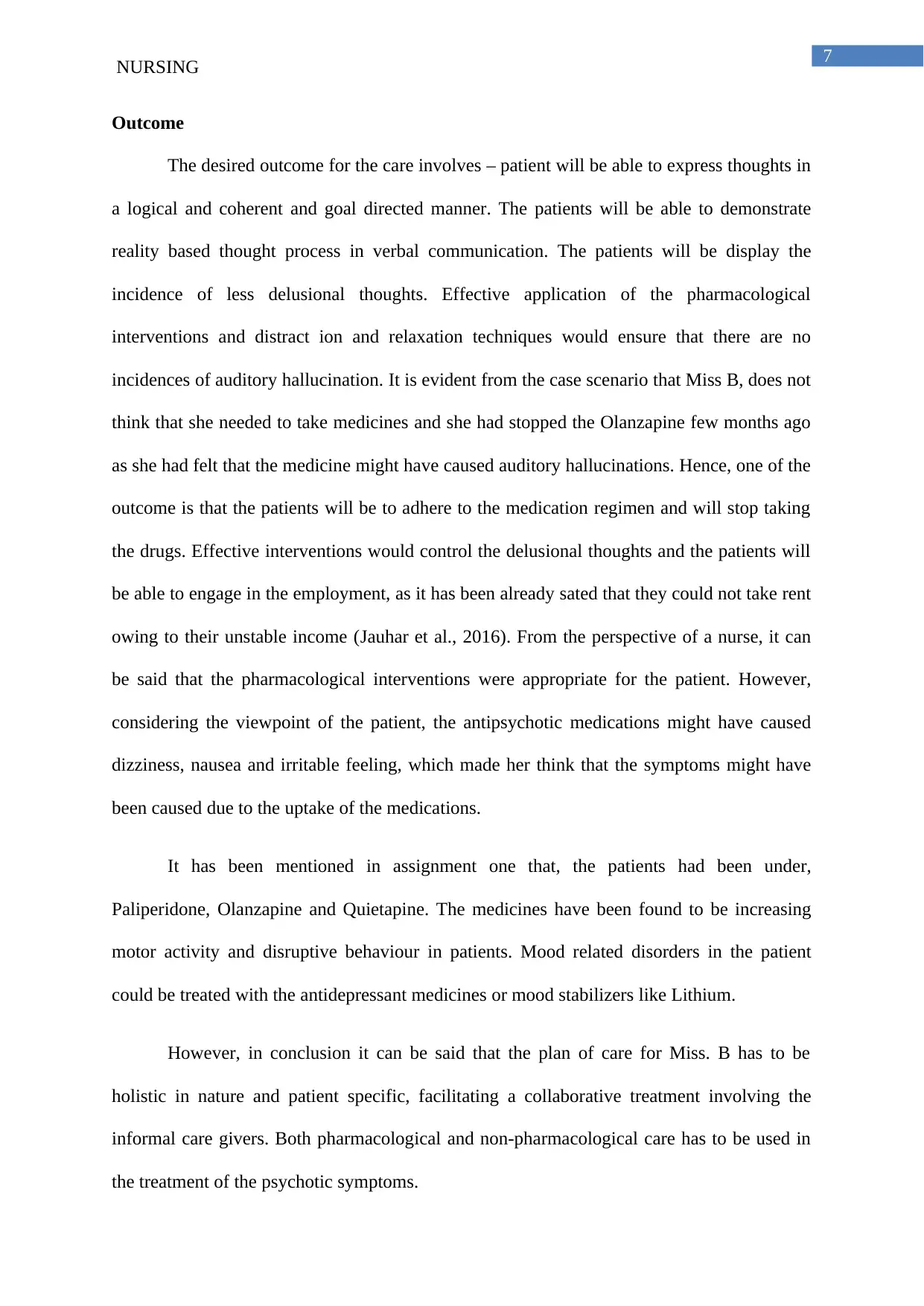
7
NURSING
Outcome
The desired outcome for the care involves – patient will be able to express thoughts in
a logical and coherent and goal directed manner. The patients will be able to demonstrate
reality based thought process in verbal communication. The patients will be display the
incidence of less delusional thoughts. Effective application of the pharmacological
interventions and distract ion and relaxation techniques would ensure that there are no
incidences of auditory hallucination. It is evident from the case scenario that Miss B, does not
think that she needed to take medicines and she had stopped the Olanzapine few months ago
as she had felt that the medicine might have caused auditory hallucinations. Hence, one of the
outcome is that the patients will be to adhere to the medication regimen and will stop taking
the drugs. Effective interventions would control the delusional thoughts and the patients will
be able to engage in the employment, as it has been already sated that they could not take rent
owing to their unstable income (Jauhar et al., 2016). From the perspective of a nurse, it can
be said that the pharmacological interventions were appropriate for the patient. However,
considering the viewpoint of the patient, the antipsychotic medications might have caused
dizziness, nausea and irritable feeling, which made her think that the symptoms might have
been caused due to the uptake of the medications.
It has been mentioned in assignment one that, the patients had been under,
Paliperidone, Olanzapine and Quietapine. The medicines have been found to be increasing
motor activity and disruptive behaviour in patients. Mood related disorders in the patient
could be treated with the antidepressant medicines or mood stabilizers like Lithium.
However, in conclusion it can be said that the plan of care for Miss. B has to be
holistic in nature and patient specific, facilitating a collaborative treatment involving the
informal care givers. Both pharmacological and non-pharmacological care has to be used in
the treatment of the psychotic symptoms.
NURSING
Outcome
The desired outcome for the care involves – patient will be able to express thoughts in
a logical and coherent and goal directed manner. The patients will be able to demonstrate
reality based thought process in verbal communication. The patients will be display the
incidence of less delusional thoughts. Effective application of the pharmacological
interventions and distract ion and relaxation techniques would ensure that there are no
incidences of auditory hallucination. It is evident from the case scenario that Miss B, does not
think that she needed to take medicines and she had stopped the Olanzapine few months ago
as she had felt that the medicine might have caused auditory hallucinations. Hence, one of the
outcome is that the patients will be to adhere to the medication regimen and will stop taking
the drugs. Effective interventions would control the delusional thoughts and the patients will
be able to engage in the employment, as it has been already sated that they could not take rent
owing to their unstable income (Jauhar et al., 2016). From the perspective of a nurse, it can
be said that the pharmacological interventions were appropriate for the patient. However,
considering the viewpoint of the patient, the antipsychotic medications might have caused
dizziness, nausea and irritable feeling, which made her think that the symptoms might have
been caused due to the uptake of the medications.
It has been mentioned in assignment one that, the patients had been under,
Paliperidone, Olanzapine and Quietapine. The medicines have been found to be increasing
motor activity and disruptive behaviour in patients. Mood related disorders in the patient
could be treated with the antidepressant medicines or mood stabilizers like Lithium.
However, in conclusion it can be said that the plan of care for Miss. B has to be
holistic in nature and patient specific, facilitating a collaborative treatment involving the
informal care givers. Both pharmacological and non-pharmacological care has to be used in
the treatment of the psychotic symptoms.

8
NURSING
NURSING
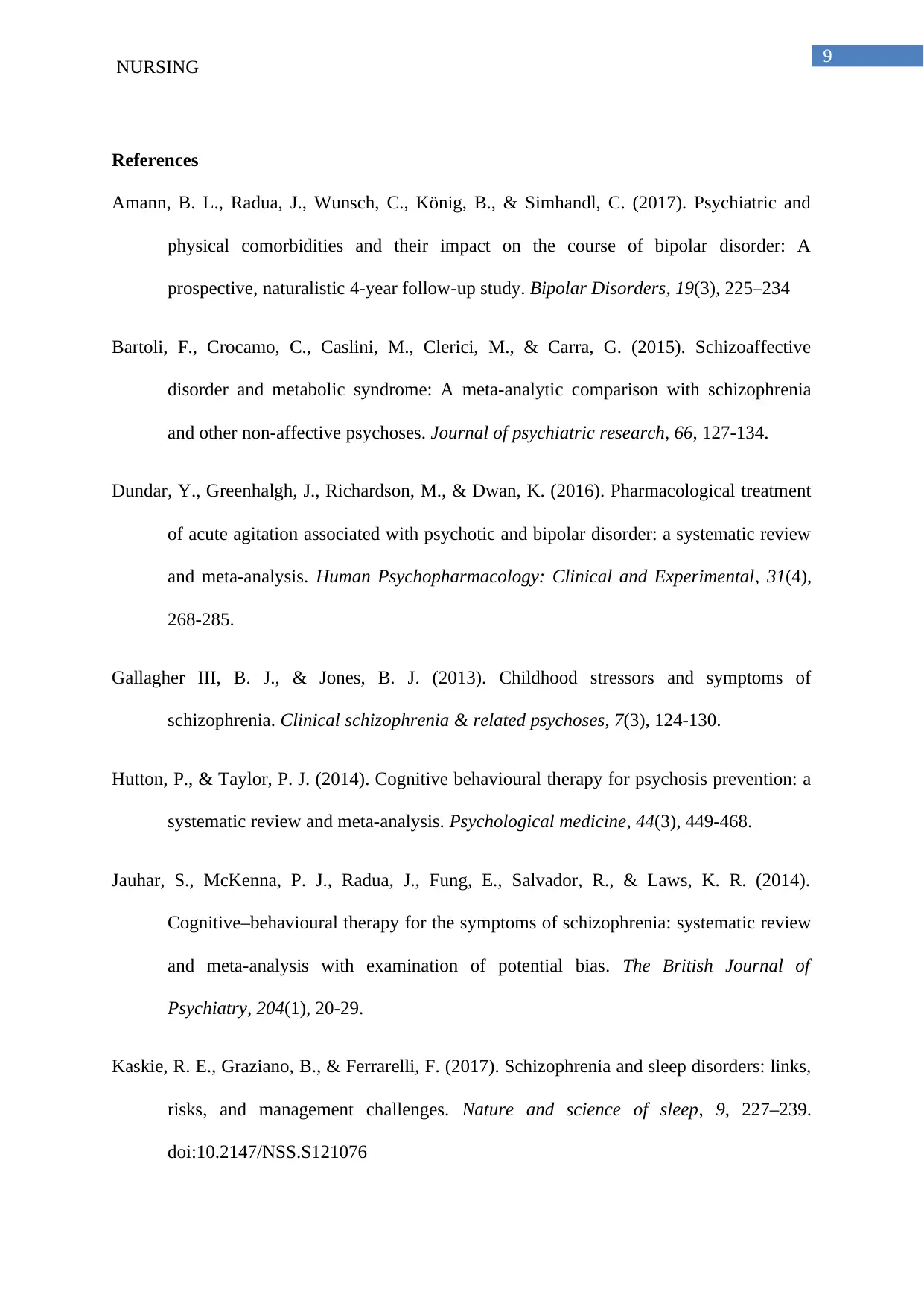
9
NURSING
References
Amann, B. L., Radua, J., Wunsch, C., König, B., & Simhandl, C. (2017). Psychiatric and
physical comorbidities and their impact on the course of bipolar disorder: A
prospective, naturalistic 4-year follow-up study. Bipolar Disorders, 19(3), 225–234
Bartoli, F., Crocamo, C., Caslini, M., Clerici, M., & Carra, G. (2015). Schizoaffective
disorder and metabolic syndrome: A meta-analytic comparison with schizophrenia
and other non-affective psychoses. Journal of psychiatric research, 66, 127-134.
Dundar, Y., Greenhalgh, J., Richardson, M., & Dwan, K. (2016). Pharmacological treatment
of acute agitation associated with psychotic and bipolar disorder: a systematic review
and meta‐analysis. Human Psychopharmacology: Clinical and Experimental, 31(4),
268-285.
Gallagher III, B. J., & Jones, B. J. (2013). Childhood stressors and symptoms of
schizophrenia. Clinical schizophrenia & related psychoses, 7(3), 124-130.
Hutton, P., & Taylor, P. J. (2014). Cognitive behavioural therapy for psychosis prevention: a
systematic review and meta-analysis. Psychological medicine, 44(3), 449-468.
Jauhar, S., McKenna, P. J., Radua, J., Fung, E., Salvador, R., & Laws, K. R. (2014).
Cognitive–behavioural therapy for the symptoms of schizophrenia: systematic review
and meta-analysis with examination of potential bias. The British Journal of
Psychiatry, 204(1), 20-29.
Kaskie, R. E., Graziano, B., & Ferrarelli, F. (2017). Schizophrenia and sleep disorders: links,
risks, and management challenges. Nature and science of sleep, 9, 227–239.
doi:10.2147/NSS.S121076
NURSING
References
Amann, B. L., Radua, J., Wunsch, C., König, B., & Simhandl, C. (2017). Psychiatric and
physical comorbidities and their impact on the course of bipolar disorder: A
prospective, naturalistic 4-year follow-up study. Bipolar Disorders, 19(3), 225–234
Bartoli, F., Crocamo, C., Caslini, M., Clerici, M., & Carra, G. (2015). Schizoaffective
disorder and metabolic syndrome: A meta-analytic comparison with schizophrenia
and other non-affective psychoses. Journal of psychiatric research, 66, 127-134.
Dundar, Y., Greenhalgh, J., Richardson, M., & Dwan, K. (2016). Pharmacological treatment
of acute agitation associated with psychotic and bipolar disorder: a systematic review
and meta‐analysis. Human Psychopharmacology: Clinical and Experimental, 31(4),
268-285.
Gallagher III, B. J., & Jones, B. J. (2013). Childhood stressors and symptoms of
schizophrenia. Clinical schizophrenia & related psychoses, 7(3), 124-130.
Hutton, P., & Taylor, P. J. (2014). Cognitive behavioural therapy for psychosis prevention: a
systematic review and meta-analysis. Psychological medicine, 44(3), 449-468.
Jauhar, S., McKenna, P. J., Radua, J., Fung, E., Salvador, R., & Laws, K. R. (2014).
Cognitive–behavioural therapy for the symptoms of schizophrenia: systematic review
and meta-analysis with examination of potential bias. The British Journal of
Psychiatry, 204(1), 20-29.
Kaskie, R. E., Graziano, B., & Ferrarelli, F. (2017). Schizophrenia and sleep disorders: links,
risks, and management challenges. Nature and science of sleep, 9, 227–239.
doi:10.2147/NSS.S121076
Secure Best Marks with AI Grader
Need help grading? Try our AI Grader for instant feedback on your assignments.

10
NURSING
Kvrgic, S., Cavelti, M., Beck, E. M., Rüsch, N., & Vauth, R. (2013). Therapeutic alliance in
schizophrenia: the role of recovery orientation, self-stigma, and insight. Psychiatry
Research, 209(1), 15-20.
Mahone, I. H., Maphis, C. F., & Snow, D. E. (2016). Effective Strategies for Nurses
Empowering Clients With Schizophrenia: Medication Use as a Tool in Recovery.
Issues in mental health nursing, 37(5), 372–379.
doi:10.3109/01612840.2016.1157228
Pfennig, A., Correll, C. U., Marx, C., Rottmann‐Wolf, M., Meyer, T. D., Bauer, M., &
Leopold, K. (2014). Psychotherapeutic interventions in individuals at risk of
developing bipolar disorder: a systematic review. Early intervention in psychiatry,
8(1), 3-11.
Rezansoff, S. N., Moniruzzaman, A., Fazel, S., McCandless, L., Procyshyn, R., & Somers, J.
M. (2016). Housing First Improves Adherence to Antipsychotic Medication Among
Formerly Homeless Adults With Schizophrenia: Results of a Randomized Controlled
Trial. Schizophrenia bulletin, 43(4), 852–861. doi:10.1093/schbul/sbw136
Santos, N. C., Costa, P., Ruano, D., Macedo, A., Soares, M. J., Valente, J., … Palha, J. A.
(2012). Revisiting thyroid hormones in schizophrenia. Journal of thyroid research,
2012, 569147. doi:10.1155/2012/569147
Sharif, K., Tiosano, S., Watad, A., Comaneshter, D., Cohen, A. D., Shoenfeld, Y., & Amital,
H. (2018). The link between schizophrenia and hypothyroidism: a population-based
study. Immunologic Research, 1-5.
Tondo, L., & Baldessarini, R. J. (2016). Suicidal behavior in mood disorders: response to
pharmacological treatment. Current psychiatry reports, 18(9), 88.
NURSING
Kvrgic, S., Cavelti, M., Beck, E. M., Rüsch, N., & Vauth, R. (2013). Therapeutic alliance in
schizophrenia: the role of recovery orientation, self-stigma, and insight. Psychiatry
Research, 209(1), 15-20.
Mahone, I. H., Maphis, C. F., & Snow, D. E. (2016). Effective Strategies for Nurses
Empowering Clients With Schizophrenia: Medication Use as a Tool in Recovery.
Issues in mental health nursing, 37(5), 372–379.
doi:10.3109/01612840.2016.1157228
Pfennig, A., Correll, C. U., Marx, C., Rottmann‐Wolf, M., Meyer, T. D., Bauer, M., &
Leopold, K. (2014). Psychotherapeutic interventions in individuals at risk of
developing bipolar disorder: a systematic review. Early intervention in psychiatry,
8(1), 3-11.
Rezansoff, S. N., Moniruzzaman, A., Fazel, S., McCandless, L., Procyshyn, R., & Somers, J.
M. (2016). Housing First Improves Adherence to Antipsychotic Medication Among
Formerly Homeless Adults With Schizophrenia: Results of a Randomized Controlled
Trial. Schizophrenia bulletin, 43(4), 852–861. doi:10.1093/schbul/sbw136
Santos, N. C., Costa, P., Ruano, D., Macedo, A., Soares, M. J., Valente, J., … Palha, J. A.
(2012). Revisiting thyroid hormones in schizophrenia. Journal of thyroid research,
2012, 569147. doi:10.1155/2012/569147
Sharif, K., Tiosano, S., Watad, A., Comaneshter, D., Cohen, A. D., Shoenfeld, Y., & Amital,
H. (2018). The link between schizophrenia and hypothyroidism: a population-based
study. Immunologic Research, 1-5.
Tondo, L., & Baldessarini, R. J. (2016). Suicidal behavior in mood disorders: response to
pharmacological treatment. Current psychiatry reports, 18(9), 88.
1 out of 11
Related Documents
Your All-in-One AI-Powered Toolkit for Academic Success.
+13062052269
info@desklib.com
Available 24*7 on WhatsApp / Email
![[object Object]](/_next/static/media/star-bottom.7253800d.svg)
Unlock your academic potential
© 2024 | Zucol Services PVT LTD | All rights reserved.





